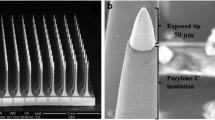Abstract
Platinum (Pt) implants coated with poly (3, 4-ethylenedioxythiophene)/carbon nanotube (PEDOT/CNT) composite films were implanted into the brain of rats, and the brain response was evaluated 6 weeks after the implantation. The surface morphology of Pt implants with and without the PEDOT/CNT coating was studied using scanning electron microscopy (SEM). After 6 weeks post-implantation, the expression of laminin (vascular endothelial marker) and neuronal nuclei (NeuN, neuronal marker) were evaluated by immnohistochemistry. It is revealed that the obvious improvements of the surface density of blood vessels and neurons aound the Pt implants with the coating, which were evidenced by laminin and NeuN staining in the zone within the distance of 150 μm to the implant interface. These results suggest the PEDOT/CNT composite films can improve the biocompatibility of the Pt electrodes while it is implanted in brain.
Similar content being viewed by others
References
Plow EB, Carey JR, Nudo RJ, et al. Invasive Cortical Stimulation to Promote Recovery of Function After Stroke: A Critical Appraisal[J]. Stroke. 2009, 40(5): 1926–1931
Hummel FC, Celnik P, Pascual-Leone A, et al. Controversy: Noninvasive and Invasive Cortical Stimulation Show Efficacy in Treating Stroke Patients[J]. Brain Stimul., 2008, 1(4): 370–382
Alonso-Alonso M, Fregni F, Pascual-Leone A. Brain Stimulation in Poststroke Rehabilitation[J]. Cerebrovasc Dis., 2007, 24Suppl 1: 157–166
Marin C, Fernandez E. Biocompatibility of Intracortical Microelec-Trodes: Current Status and Future Prospects[J]. Front Neuroeng., 2010, 3: 8
Polikov VS, Tresco PA, Reichert WM. Response of Brain Tissue to Chronically Implanted Neural Electrodes[J]. J. Neurosci. Methods, 2005, 148(1): 1–18
Lu Y, Li T, Zhao X, et al. Electrodeposited Polypyrrole/Carbon Nanotubes Composite Films Electrodes for Neural Interfaces[J]. Biomaterials, 2010, 31(19): 5 169–5 181
Tasis D, Tagmatarchis N, Bianco A, et al. Chemistry of Carbon Nanotubes[J]. Chem. Rev., 2006, 106(3): 1 105–1 136
Abidian MR, Kim DH, Martin DC. Conducting-Polymer Nanotubes for Controlled Drug Release[J]. Adv. Mater., 2006, 18(4): 405–409
P M Ajayan LSSC. Single-walled Carbon Nanotube-polymer Composites: Strength and Weakness[Z]. 2000750-753
Macdonald RA, Laurenzi BF, Viswanathan G, et al. Collagen-Carbon Nanotube Composite Materials as Scaffolds in Tissue Engineering[J]. J. Biomed. Mater. Res. A., 2005, 74(3): 489–496
Correa-Duarte M A NWJR. Fabrication and Biocompatability of Carbon Nanotube-based 3D Networks as Scaffolds for Cell Seeding and Growth[Z]. 2004: 4, 2233–2236
Richardson-Burns SM, Hendricks JL, Foster B, et al. Polymerization of the Conducting Polymer Poly(3,4-ethylenedioxythiophene) (PEDOT) Around Living Neural Cells[J]. Biomaterials, 2007, 28(8): 1 539–1 552
Lu Y, Li Y, Pan J, et al. Poly(3,4-ethylenedioxythiophene)/Poly(Styrenesulfonate)-Poly(Vinyl Alcohol)/Poly(Acrylic Acid) Interpenetrating Polymer Networks for Improving Optrode-neural Tissue Interface in Optogenetics[J]. Biomaterials, 2012, 33(2): 378–394
Baba T, Kameda M, Yasuhara T, et al. Electrical Stimulation of the Cerebral Cortex Exerts Antiapoptotic, Angiogenic, and Anti-inflammatory Effects in Ischemic Stroke Rats Through Phosphoinositide 3-kinase/Akt Signaling Pathway[J]. Stroke, 2009, 40(11): e598–e605
Author information
Authors and Affiliations
Corresponding authors
Additional information
Funded by the High Tech Research and Development (“863”) Program of China (2006AA02Z4E6) and the National Natural Science Foundation of China (Nos. 21073136, 81271364)
Rights and permissions
About this article
Cite this article
Cheng, X., Li, C., Rao, L. et al. Platinum wire implants coated with PEDOT/carbon nanotube conducting polymer films in the brain of rats: A histological evaluation. J. Wuhan Univ. Technol.-Mat. Sci. Edit. 27, 1053–1057 (2012). https://doi.org/10.1007/s11595-012-0599-8
Received:
Accepted:
Published:
Issue Date:
DOI: https://doi.org/10.1007/s11595-012-0599-8




